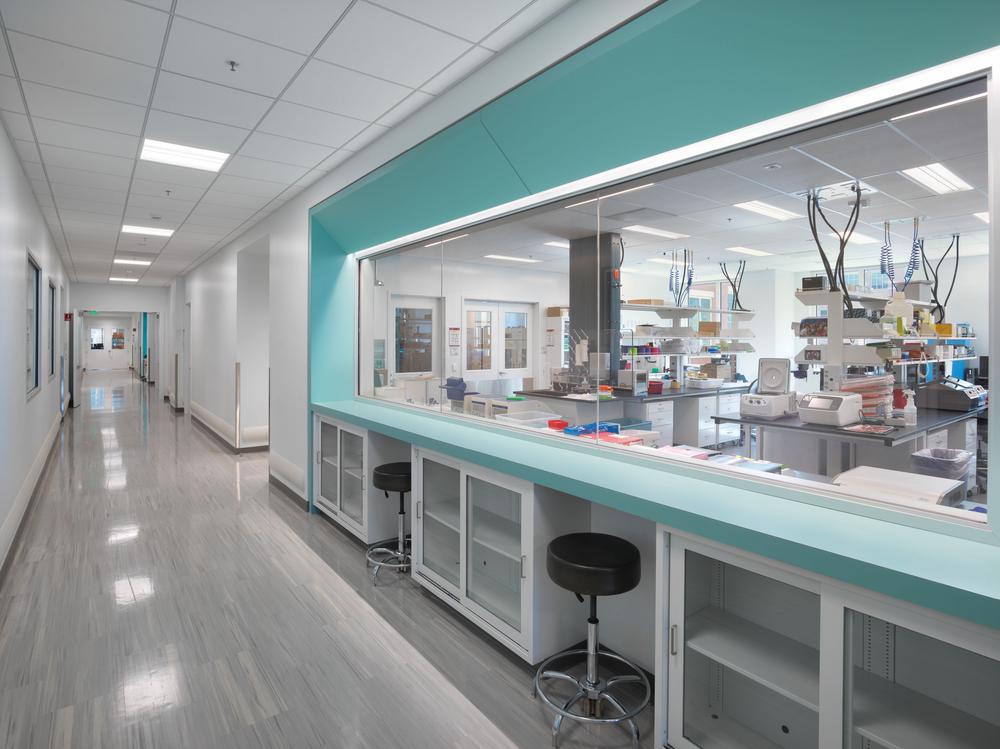News & Insights
Creating flexibility and resilience in life science research facilities
Structural engineering for life science research labs is complex. This article highlights the issues research facilities face in creating resilience, and how smart structural design can deliver solutions.

Life science research facilities need to be flexible to adapt to the pace of changing scale, emerging testing needs, breakthroughs, and crisis situations. But achieving this adaptability in the built environment can be a challenge.
This article highlights the issues research facilities face in creating flexibility and resilience, and how smart structural design can deliver solutions.
Creating flexibility in structural ground floors
Research facilities are most often developed in science hubs near infrastructure, capital, and talent. Yet some geographic hubs have built-in challenges to be resolved when building labs.
For example, in the San Francisco Bay Area, the soil is unstable so the structure can’t depend on the ground to support it. Instead, buildings need to sit on piles that go into the earth from 50 feet to 180 feet to bypass the poor soil to hit substantial ground. Grade beams are used with the piles to create a structural ground floor.
Yet structural ground floors aren’t inherently flexible when potential changes need to be made. You don’t want to cut into a grade beam in a structure where the soil is going to pull away over time.
To mitigate this, scenario planning allows us to design floors so that they can be cut into for predicted future uses without damaging the structure. Another strategy we leverage is to pre-engineer the underground mechanical utilities so they can be tied into below corridors.
Maintaining operation through earthquakes and hurricanes
While earthquakes, hurricanes, and other natural disasters are difficult for all businesses, they can create catastrophic results to pharmaceutical product campaigns in loss of output materials and time.
Most building codes focus on protecting life—making sure a building can stand so that everyone can exit safely. But for research facilities in areas with high seismic activity, windborne events, and other naturally occurring hazards, resilience means maintaining operation during and after significant events. There are many different structural avenues to harden a building so that it can achieve that depending on the context.
We worked with Gilead Sciences—a leader in the antiviral drugs used to treat HIV/AIDS, hepatitis, and COVID-19—on a pilot plant here in the United States. Reliability and redundancy were essential for them. The building was designed with resilience, providing design to toughen the structure of the building to ensure it would remain operational after a major natural disaster.
An intense amount of coordination between the Architectural and MEP+F disciplines is always necessary to make this possible. Clear communication with the client regarding performance expectations at the onset of the project is critical.
Right-size planning for vibration control
Imaging, radiology, and vivariums require sophisticated structural approaches to vibration control. It’s simple if these sensitive spaces will always be in the same locations, but what happens in the future if those areas need to expand into adjacent spaces or move to another part of the building?
Vibration isolation approaches add cost, but conversations during the planning phases can help clients determine where these types of spaces are needed now and where they may likely be desired in the future. This pre-planning gives the design team the ability to strike a balance between future flexibility and right-sized approaches so that vibration measures aren’t wasted.
For Merck’s 300,000 sf west coast headquarters and lab building in San Francisco, we worked carefully with the team to align vibration control for sensitive areas while working with lab planners and process engineers to extrapolate options for the future to maximize flexibility.
Combining research and patient care
The latest genetic and cellular therapies have added a patient care component to life science research facilities. Outpatient clinics—where the patient provides genetic material to be modified onsite—requires different programming to the labs needed to process the material.
Both types of spaces have demanding mechanical, electrical, and plumbing needs, but the systems between the spaces cannot mix. To keep systems separate, while still delivering the right components to the right places is a challenge of coordination between all the members of the design and construction team to execute well.
We worked with BioMarin—a leader in therapies for rare genetic diseases—to create a research facility that would meet the needs of research and patient care.
The promise (and limitations) of modular construction
Modular construction has become a popular way to create flexibility and reduce timelines in the building of life science research facilities.
These self-contained spaces are designed with the mechanical, electrical, and plumbing systems included with mechanisms to hook together into the main system. (On a lab build, the core mechanical systems are typically on the roof routing to the appropriate spaces.)
Structurally, the modular units need to be able to sit on the slab without issues. We often have to strengthen the floor above in modular construction to make sure it can handle the load of anything that is suspended.
One of the most effective uses of modular constructions—especially in GMP facilities–is in modular clean rooms. These units can effectively be integrated into existing buildings and be up and running quickly.
The drawback to modular construction is that the client’s program needs to fit well within the pre-defined performance of the manufactured unit. While the units can be combined and configured as a whole to create flexibility, within each space customization is difficult to achieve.
The flexibility of adaptive reuse
Commercial real estate developers are converting traditional office buildings into research labs. The shift to work-from-home in the commercial sector has emptied prime office space in biopharma research hubs creating opportunities for adaptive reuse.
Salas O’Brien consults with developers to determine if buildings can be successfully converted for lab use. Structurally, slab-to-slab heights need to be evaluated along with the capacity of the floors to support extra load for equipment. Another issue we screen for is the ability to mitigate vibration.
Auris Health, a Johnson and Johnson company, has developed a biomedical device manufacturing facility within an existing 80,000 square foot multi-storied office building in San Jose, CA. Salas O’Brien structural engineers provided the necessary expertise to seismically enhance the building as well as improve the floor loading capacity to house this new facility.
Early planning creates future options
Designing resilience for research environments is a dance between lab planners, MEP designers, structural and process engineers. Smart discussions early in the design phase can support interchangeability years after opening.
As the demands on life science facilities increase, so does the need for flexibility—a trend that is playing out across the spectrum for pharmaceuticals, healthcare, government, and university research facilities. Our client work maximizes the built environment to facilitate this interoperability and adaptation.
For media inquiries on this article, reach out to Stacy Lake.

Jim Passaglia, SE, SECB
Jim Passaglia is a Principal with Salas O’Brien with over 40 years of professional experience in a diverse range of sectors, including life sciences, pharmaceutical, acute-care hospitals, and academic. Jim specializes in high-performance buildings with a great deal of complexity and has served client startups through biopharmaceutical Fortune 500 companies such as Abbot, Bayer, BioMarin, Deltagen, Gilead Sciences, and Merck. Contact him at [email protected].

Jonathan Wong, SE, LEED AP
Jonathan Wong serves as a Vice President on our structural team. He is a highly skilled project engineer and designer serving a diverse range of structures, including life-science, microelectronic, acute-care, retail, and commercial. He is well-known in the industry for functional and efficient designs with well-coordinated construction documents. He focuses on constructability during the design phase and responsiveness during construction. Contact him at [email protected].